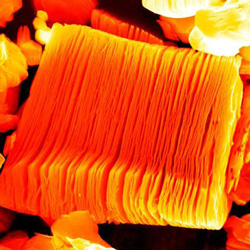While searching for new materials for electrical energy storage, a team of Drexel University materials scientists has discovered a new family of two-dimensional compounds proposed to have unique properties that may lead to groundbreaking advances in energy storage technology.
The research team recounts transformed three dimensional titanium-aluminum carbide, a typical representative of a family of layered ternary carbides called MAX phases, into a two dimensional structure with greatly different properties. MAX phases, known as ductile and machineable ceramics, have been researched by Prof. Barsoum’s lab for more than a decade and dozens of layered carbides, nitrides and carbonitrides with a variety of properties have been synthesized. However, these ceramics have always been produced as 3-dimensional materials
Scanning electron micrograph of an exfoliated particle with the size of about 10 micrometers. MXene sheets can be separated by sonication. (Image: SEM – B. Anasori, color – P. Gogotsi)
2D Ti3C2 nanosheets, multilayer structures, and conical scrolls produced by room temperature exfoliation of Ti3AlC2 in HF are reported. Since Ti3AlC2 is a member of a 60+ group of layered ternary carbides and nitrides, this discovery opens a door to the synthesis of a large number of other 2D crystals.
The Drexel researchers placed titanium-aluminum carbide (Ti3AlC2) powders in hydrofluoric acid at room temperature to selectively remove the aluminum. The result of this chemical process, referred to as exfoliation, essentially spreads-out the layered carbide material and yields two-dimensional Ti3C2 nanosheets, which have since been coined MXene, as a kin to graphene. Most notable is that the exfoliated material shows many features of graphene. For example, it can roll into nanotube-like scrolls, some with diameters of less than 40 nanometers (1000 times thinner than a human hair), having the potential for a broad range of applications, ranging from energy storage devices to biomedical applications and composites.
The scientists present their case using an array of experimental techniques and first principles calculations. High-resolution transmission electron microscopy, performed in collaboration with researchers from Sweden, has demonstrated presence of single, double and multilayer sheets with the lateral dimension of several micrometers and thicknesses in the nanometer range. The calculations predict large elastic moduli and an electronic structure that can be tuned by changing the surface chemistry of these sheets.
“Two-dimensional free-standing crystals, such as graphene, boron nitride and metal
chalcogenides (for example, molybdenum disulfide), can differ strikingly in properties from their three-dimensional counterparts. Currently, however, there are relatively few such atomically layered materials.” said Michael Naguib, a doctoral candidate and first author of the article.“Since Ti3AlC2 is a member of the MAX phase family, that to date number over 60, the
importance of this study lies far beyond simply the formation of Ti3C2 nanosheets. We are not talking about one composition here, but a very large family indeed, thus opening tremendous opportunities in synthesis and application of 2-D materials. This work provides a conceptual leap forward that should lead to a breakthrough in the development of two-dimensional materials.” Gogotsi said
If you liked this article, please give it a quick review on ycombinator or StumbleUpon. Thanks

Brian Wang is a Futurist Thought Leader and a popular Science blogger with 1 million readers per month. His blog Nextbigfuture.com is ranked #1 Science News Blog. It covers many disruptive technology and trends including Space, Robotics, Artificial Intelligence, Medicine, Anti-aging Biotechnology, and Nanotechnology.
Known for identifying cutting edge technologies, he is currently a Co-Founder of a startup and fundraiser for high potential early-stage companies. He is the Head of Research for Allocations for deep technology investments and an Angel Investor at Space Angels.
A frequent speaker at corporations, he has been a TEDx speaker, a Singularity University speaker and guest at numerous interviews for radio and podcasts. He is open to public speaking and advising engagements.


